| Common name | Binomial name | Population | Status | Trend | Notes | Image |
|---|
| New Caledonian owlet-nightjar | Aegotheles savesi | 1-49 [1] | CR [1] |  [1] [1] | The most recent sighting is in 1998. [1] |  |
| New Caledonian nightjar | Eurostopodus exul | 1-49 [2] | CR [2] | ? [2] | There is only one specimen ever taken in 1939. [2] | |
| Jamaican poorwill | Siphonorhis americana | 1-49 [3] | CR [3] | ? [3] | No records since 1860. [3] |  |
| White-winged nightjar | Eleothreptus candicans | 600-1,700 [4] | VU [4] |  [4] [4] | Actual population may be larger. [4] | 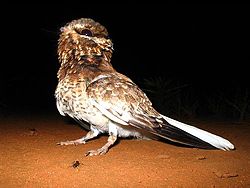 |
| Puerto Rican nightjar | Caprimulgus noctitherus | 930-1,300 [5] | EN [5] |  [5] [5] | This estimate is based on 712 males found within a portion of its range. [5] |  |
| Solomons nightjar | Eurostopodus nigripennis | 1,000-2,499 [6] | VU [6] |  [6] [6] | Estimate from lack of records and species small range. [6] |  |
| Palau nightjar | Caprimulgus phalaena | 1,000-2,499 [7] | NT [7] |  [7] [7] | Preliminary estimate. [7] | |
| Prigogine's nightjar | Caprimulgus prigoginei | 2,500-9,999 [8] | EN [8] |  [8] [8] | Estimate comes from consideration of habitat and last recorded specimen was in 1955. [8] | |
| Satanic nightjar | Eurostopodus diabolicus | 2,500-9,999 [9] | VU [9] |  [9] [9] | |  |
| Sickle-winged nightjar | Eleothreptus anomalus | 2,500-52,000 [10] | VU [10] |  [10] [10] | Large population variation is due to the common appearances, but apparent scarcity of the species (i.e. they are mostly nocturnal, which makes observing them harder, and they often only a lone individual is sighted). [10] | |
| Least poorwill | Siphonorhis brewsteri | 4,140 [11] | NT [11] |  [11] [11] | Estimate is calculated from population density and available habitat. [11] | |
| Salvadori's nightjar | Caprimulgus pulchellus | 6,000-15,000 [12] | NT [12] |  [12] [12] | Estimate comes from limited available habitat. [12] | |
| Bonaparte's nightjar | Caprimulgus concretus | 10,000-19,999 [13] | VU [13] |  [13] [13] | Preliminary estimate. [13] |  |
| Choco poorwill | Nyctiphrynus rosenbergi | 10,000-19,999 [14] | LC [14] |  [14] [14] | Preliminary estimate. [14] |  |
| Eared poorwill | Nyctiphrynus mcleodii | 20,000-49,999 [15] | LC [15] |  [15] [15] | | |
| Yucatan poorwill | Nyctiphrynus yucatanicus | 20,000-49,999 [16] | LC [16] |  [16] [16] | |  |
| Dusky nightjar | Antrostomus saturatus | 20,000-49,999 [17] | LC [17] |  [17] [17] | |  |
| Short-tailed nighthawk | Lurocalis semitorquatus | 50,000-499,999 [18] | LC [18] |  [18] [18] | |  |
| Spot-tailed nightjar | Caprimulgus maculicaudus | 50,000-499,999 [19] | LC [19] |  [19] [19] | |  |
| Yucatan nightjar | Caprimulgus badius | 50,000-499,999 [20] | LC [20] |  [20] [20] | | |
| Tawny-collared nightjar | Antrostomus salvini | 50,000-499,999 [21] | LC [21] |  [21] [21] | |  |
| Antillean nighthawk | Chordeiles gundlachii | 200,000 [22] | LC [22] |  [22] [22] | |  |
| Mexican whip-poor-will | Antrostomus arizonae | 320,000 [23] | LC [23] |  [23] [23] | |  |
| White-tailed nightjar | Hydropsalis cayennensis | 500,000-4,999,999 [24] | LC [24] |  [24] [24] | |  |
| Ocellated poorwill | Nyctiphrynus ocellatus | 500,000-4,999,999 [25] | LC [25] |  [25] [25] | | 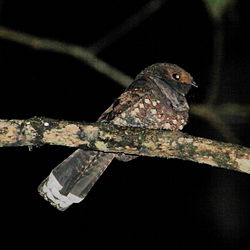 |
| Red-necked nightjar | Caprimulgus ruficollis | 575,000-770,000 [26] | NT [26] |  [26] [26] | Consists of two subspecies, so these estimates are very preliminary. [26] |  |
| Common poorwill | Phalaenoptilus nuttallii | 1,700,000 [27] | LC [27] |  [27] [27] | |  |
| Eastern whip-poor-will | Antrostomus vociferus | 1,800,000 [28] | NT [28] |  [28] [28] | |  |
| Buff-collared nightjar | Antrostomus ridgwayi | 2,000,000 [29] | LC [29] |  [29] [29] | |  |
| European nightjar | Caprimulgus europaeus | 3,000,000-5,999,999 [30] | LC [30] |  [30] [30] | European population estimated at 1,230,000-2,200,000, so very preliminary estimate of global population. [30] | 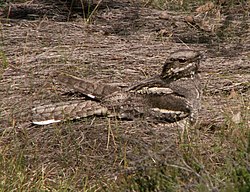 |
| Rufous nightjar | Antrostomus rufus | 5,000,000-49,999,999 [31] | LC [31] |  [31] [31] | | 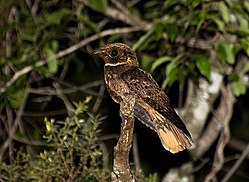 |
| Chuck-will's-widow | Antrostomus carolinensis | 5,700,000 [32] | NT [32] |  [32] [32] | |  |
| Pauraque | Nyctidromus albicollis | 20,000,000 [33] | LC [33] |  [33] [33] | |  |
| Common nighthawk | Chordeiles minor | 23,000,000 [34] | LC [34] |  [34] [34] | | 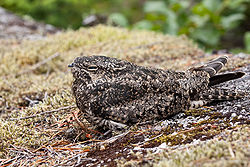 |
|



























